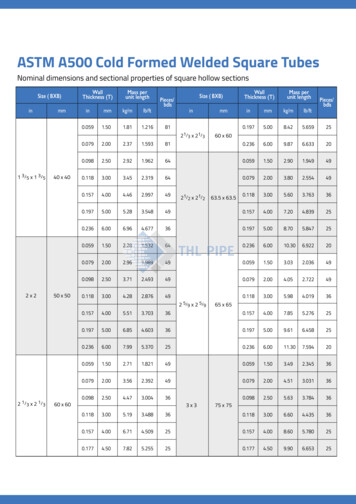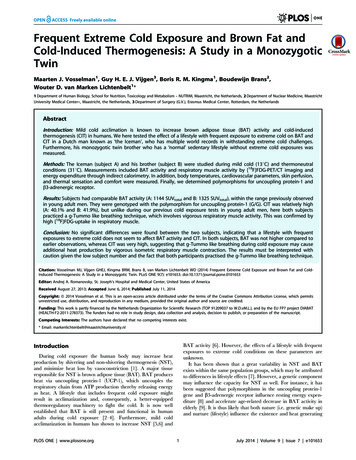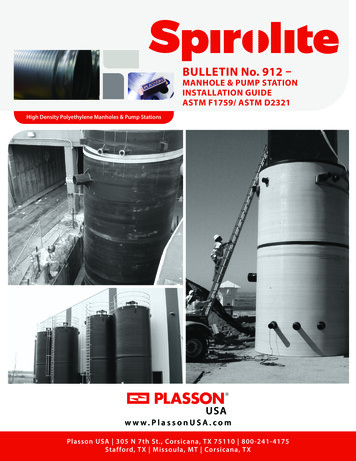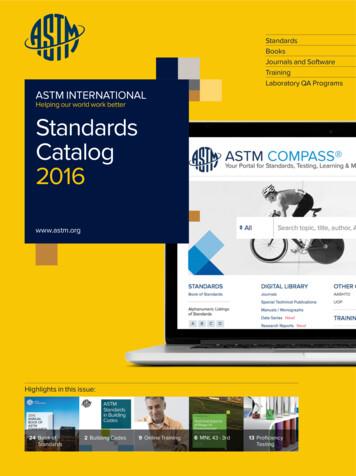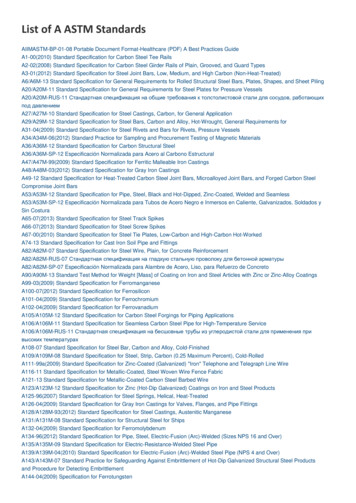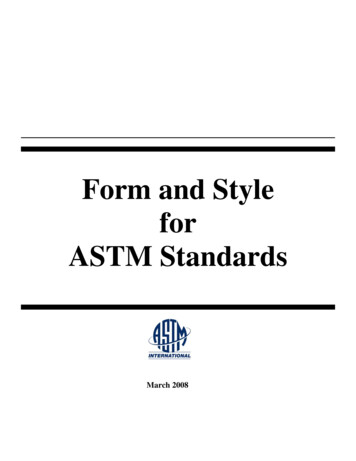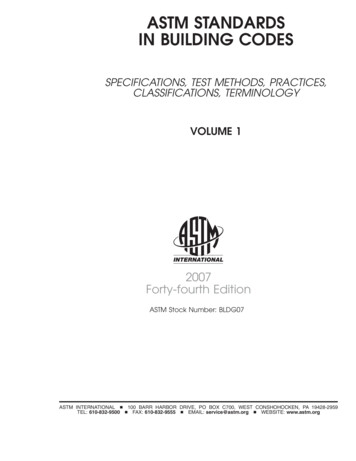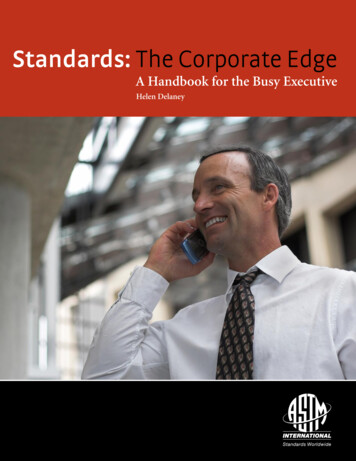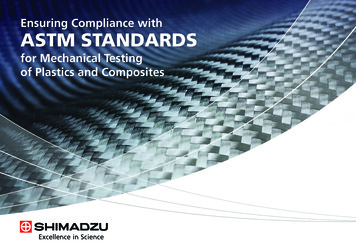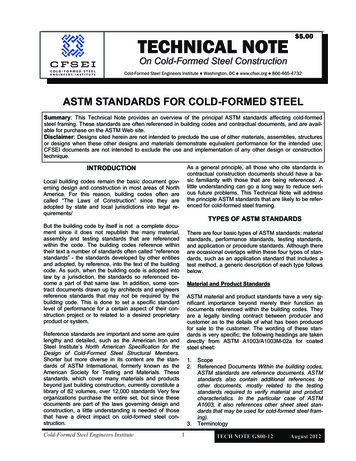
Transcription
TECHNICAL NOTEtest 5.00 5.00On Cold-Formed Steel ConstructionCold-Formed Steel Engineers Institute Washington, DC www.cfsei.org 866-465-4732ASTM STANDARDS FOR COLD-FORMED STEELSummary: This Technical Note provides an overview of the principal ASTM standards affecting cold-formedsteel framing. These standards are often referenced in building codes and contractual documents, and are available for purchase on the ASTM Web site.Disclaimer: Designs cited herein are not intended to preclude the use of other materials, assemblies, structuresor designs when these other designs and materials demonstrate equivalent performance for the intended use;CFSEI documents are not intended to exclude the use and implementation of any other design or constructiontechnique.As a general principle, all those who cite standards incontractual construction documents should have a basic familiarity with those that are being referenced. Alittle understanding can go a long way to reduce serious future problems. This Technical Note will addressthe principle ASTM standards that are likely to be referenced for cold-formed steel framing.INTRODUCTIONLocal building codes remain the basic document governing design and construction in most areas of NorthAmerica. For this reason, building codes often arecalled “The Laws of Construction” since they areadopted by state and local jurisdictions into legal requirements/TYPES OF ASTM STANDARDSBut the building code by itself is not a complete document since it does not republish the many material,assembly and testing standards that are referencedwithin the code. The building codes reference withintheir text a number of standards often called “referencestandards” - the standards developed by other entitiesand adopted, by reference, into the text of the buildingcode. As such, when the building code is adopted intolaw by a jurisdiction, the standards so referenced become a part of that same law. In addition, some contract documents drawn up by architects and engineersreference standards that may not be required by thebuilding code. This is done to set a specific standardlevel of performance for a certain aspect of their construction project or to related to a desired proprietaryproduct or system.There are four basic types of ASTM standards: materialstandards, performance standards, testing standards,and application or procedure standards. Although thereare occasional overlaps within these four types of standards, such as an application standard that includes atest method, a generic description of each type followsbelow.Material and Product StandardsASTM material and product standards have a very significant importance beyond merely their function asdocuments referenced within the building codes. Theyare a legally binding contract between producer andcustomer as to the details of what has been producedfor sale to the customer. The wording of these standards is very specific; the following headings are takendirectly from ASTM A1003/A1003M-02a for coatedsteel sheet:Reference standards are important and some are quirelengthy and detailed, such as the American Iron andSteel Institute’s North American Specification for theDesign of Cold-Formed Steel Structural Members.Shorter but more diverse in its content are the standards of ASTM International, formerly known as theAmerican Society for Testing and Materials. Thesestandards, which cover many materials and productsbeyond just building construction, currently constitute alibrary of 82 volumes, over 12,000 standards Very feworganizations purchase the entire set, but since thesedocuments are part of the laws governing design andconstruction, a little understanding is needed of thosethat have a direct impact on cold-formed steel construction.Cold-Formed Steel Engineers Institute1.2.3.1ScopeReferenced Documents Within the building codes,ASTM standards are reference documents. ASTMstandards also contain additional references toother documents, mostly related to the testingstandards required to verify material and productcharacteristics. In the particular case of ASTMA1003, it also references other sheet steel standards that may be used for cold-formed steel framing).TerminologyTECH NOTE G800-12August 2012
4.5.6.7.8.9.10.11.12.13.14.Classification Many standards define more thanone product within a common grouping of products).Order Information (This section outlines the variousspecific terms for ordering material and what willbe supplied in the absence of specific orderinginformation).Materials and ManufactureChemical CompositionMechanical PropertiesCoating PropertiesNumber of TestsRetests and ResamplesCertificationProduct MarkingKeywordsREFERENCING ASTM STANDARDSSome care needs to be taken as to which version of astandard is referenced in any particular building codeor contract documents. ASTM identifies the currentstandards by the term “Active Standard,” defined as“.the current, official version of an ASTM standard. AnActive Standard supersedes previous historical versions of a standard.” By its own internal regulations,ASTM will not permit a standard to pass a five-yearanniversary, unchanged, without being reviewed and re-balloted. By this means, ASTM standards are considered to represent “best current practice.”Building codes operate on a similar cycle of review andrenewal, but in typical increments of three to five years.Since there is no official coordination between the updating of ASTM standards and the building codes thatreference them, the building code may (and probablywill) contain a referenced standard that is not the current, Active version. It would be convenient if the building codes referenced standards as the “latest version.”but since the building code is a legal document it cannot contain reference to some future document thatwas not in the public domain at the time of adopting thebuilding code. Specification writers, architects and engineers should be cautioned against the same issue,since revisions to existing standards may be issuedduring the course of a project.This ASTM A1003 standard has six pages of fine printand three tables, and defines a product in detail. If steelsheet material is supplied by a producer to this specificASTM standard number, it constitutes a guarantee thatthe product meets the requirements of what has beenspecified in the order. It is for this reason that theASTM standards are referenced in the building codes it guarantees that what is purchased meets or exceedsa minimum standard of compliance.ASTM Performance StandardsJust as architectural specifications may give either material or performance requirements, ASTM standardsmay specify a minimum level of performance for aproduct or system. (For example, the height of a steelframed wall system can span under a specified loadand still meet a given deflection criterion.) In somecase, material and performance criteria are intermixed.(A product manufacturer may be given the opportunityto either produce a product to strict material dimensions or to a specified minimum performance requirement.)PRINCIPAL STANDARDS FOR COLDFORMED STEEL FRAMINGThe following list of ASTM standards is not all encompassing, but represents the key ones applicable to cold-formed steel framing. They have been prioritized (boldtype) for their importance to a designer or contractor,principally along the lines of their need for either theselection (or purchase) of materials or their guidelinesfor a construction practice. They key standards for testing materials for compliance with a materials standard,such as the standard for determining the weight of agalvanized coating, are listed without recommendationfor their inclusion in a designer’s or contractor’s libraryof standards.ASTM Test StandardsThese standards define the physical equipment, operating procedures and reporting protocol for tests conducted on both materials and assemblies of materials.One such example is ASTM E119, Standard TestMethods for Fire Tests of Building Construction andMaterials, which defines in detail all the operationalprotocols of conducting fire tests on materials and assemblies used for construction and subjected to structural loading.For more details on any of the standards listed below,information on the full scope of the standard as well asreferenced documents cited by the standard may befound free of charge at the ASTM web site. The complete text of any standard is available only by purchasefrom ASTM or from a reprint that has been made withASTM’s written permission.ASTM Application or Procedure StandardsThe numbering system for ASTM standards followsspecific rules, using as an example the above mentionssteel sheet standard ASTM A1003/A1003M-02a:These standards define procedures such as the repairof products manufactured to other ASTM standards.One such example is ASTM A780, Standard Practicefor Repair of Damaged and Uncoated Areas of Hot-DipGalvanized Coatings. This standard defines, in detail,three different and acceptable ways of repairing damage to a galvanized coating on steel substrate.TECH NOTE G800-12August 2012 2The “A” is for a grouping of standards, in this caseIron and Steel Products.Cold-Formed Steel Engineers Institute
with various application requirements.The number “1003” is the specific number of thestandard. Standards are numbered in the sequence of their development so the number haslittle significance other than the standard’s locationwithin an ASTM published volume or CD-ROM.The “A1003M” designation indicates that the standard is published in both Inch-Pound and SI Units.The “02” is the year that the standard was issued.The “a” indicates that an editorial change has beenmade since the latest issue of the standard. If additional editorial changes are made prior to a revisedissue of the standard, letters “b” and higher will beused as needed.ASTM A755/A755M -, Standard Specification for SteelSheet, Metallic Coated by the Hot-Dip Process andPrepainted by the Coil-Coating Process for ExteriorExposed Building Products.This specification covers coated steel sheet furnishedin coils, cut lengths and formed cut lengths, includingcorrugated and various types of roll and brake-formedconfigurations. The base steel sheet can be metalliccoated by a number of different hot-dip process and theprepainting can be many combinations of primer andsingle or multiple additional coatings of a wide range ofpaint systems.THE FOLLOWING STANDARDS COVER THESHEET STEELS THAT, BY SUBSEQUENTOPERATIONS, CAN BE FORMED INTOFRAMING MEMBERSASTMA792/A792M -, Standard Specification for SteelSheet, 55% Aluminum-Zinc-Alloy-Coated by the HotDip Process.This specification covers the proprietary product commonly know as Galvalume which may occasionally beused for steel sheet base for exterior applications ofroofing and siding. The corrosion resistance of thisproduct is significantly higher than that of an equalcoating thickness of zinc (galvanizing).ASTM A1003/A1003M - , Standard Specification forSteel Sheet, Carbon, Metallic- and Nonmetallic-Coatedfor Cold-Formed Framing Members.This specification covers the coated steel sheet usedspecifically for the manufacture of cold-formed framingmembers, including but limited to studs, joists, purlins,girts and track. ASTM A1003 was developed to includeand reference sheet steel standards ASTM A653,A792, A875, A876 and A463, provide additional optionsfor supplies, and be consistent with the material requirements of the AISI North American Specification forthe Design of Cold-Formed Steel Structural Members.NOTE TO SPECIFIERS: This standard is most likelythe one you should cite for the sheet steel used for cold-formed steel framing.ASTM A875/A875M -, Standard Specification for SteelSheet, Zinc-5% Aluminum Alloy-Coated by the Hot-DipProcess.This specification covers the proprietary product commonly known as Galfan , which, as for Galvalume, isprincipally used for exterior applications. The corrosionresistance of this product is similar to that of galvanizedsteel sheet, but its forming characteristics are superiorto both galvanized and Galvalume.ASTM A463/A463M -, Standard Specification for SteelSheet, Aluminum Coated, by the Hot-Dip Process.ASTM A924/A924M -, Standard Specification for General Requirements for Steel Sheet, Metallic-Coated bythe Hot-Dip Process.This specification covers steel sheet in coils and cutlengths available with two types of aluminum coatingand several different coating weights applied by the hot-dip process.This specification covers the general requirements thatapply to steel sheet in coils and cut lengths that aremetallic coated on continuous lines by the hot-dip process. These products are intended for applications requiring corrosion resistance and the specifications contain the requirements for specific strength levels, heatresistance, paintability, or formability, or any combination thereof.ASTM A500 -, Standard Specification for Cold-FormedWelded and Seamless Carbon Steel Structural Tubingin Rounds and Shapes.This specification covers carbon steel round, square,rectangular or special shaped structural tubing forbuildings, bridges and other general structural purposes.THE FOLLOWING STANDARDS COVER THEFRAMING MEMBERS ONE THEY AREFORMED INTO STUDS AND TRACKSASTM A653/A653M -, Standard Specification for SteelSheet, Zinc-Coated (Galvanized) or Zinc-Iron-AlloyCoated (Galvannealed) by the Hot-Dip Process.They include tolerances on length, bow, camber andtwist; plus some performance and marking requirements.This specification covers steel sheet in coils and cutlengths and produced to a large number of designations, grades and classes designed for compatibilityCold-Formed Steel Engineers Institute3TECH NOTE G800-12August 2012
ASTM C645, Standard Specification for NonstructuralSteel Framing Members.THE FOLLOWING STANDARDS ARE FORSCREWS AND GYPSUM PANEL PRODUCTSThis covers non-structural members used for interiorconstruction assemblies only. It covers material thateither has a bare steel
Mechanical Properties 9. Coating Properties 10. Number of Tests 11. Retests and Resamples 12. Certification 13. Product Marking 14. Keywords This ASTM A1003 standard has six pages of fine print and three tables, and defines a product in detail. If steel sheet material is supplied by a producer to this specific ASTM standard number, it constitutes a guarantee that the product meets the .
